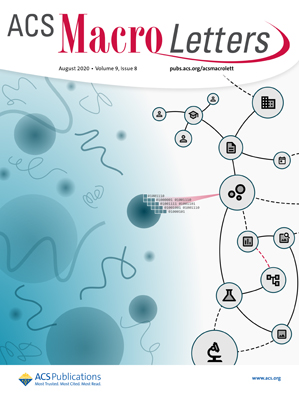Poly(siloxane)-Derived Ionosilicone Elastomers Reveal the Role of Interfacial Polymer Dynamics in Ionic Double-Layer Rectification
IF 5.1
Q1 POLYMER SCIENCE
引用次数: 0
Abstract
Poly(siloxane ionic liquid)s (PSILs) have highly flexible siloxane backbones, affording them low glass transition temperatures and therefore high solvent-free ionic conductivity at ambient temperature, offering promise for ion-mediated electronic devices. Here, cross-linked, highly conductive (>4 × 10–3 mS/cm) cationic and anionic PSILs (termed ionosilicones) were prepared. The backbone of these ionosilicone networks could be tuned by copolymerization with acrylate monomers to create ionosilicone–acrylate hybrid networks with intermediate properties. When two oppositely charged networks are brought into contact, an ionic double layer (IDL) consisting of fixed cations and anions is formed, and the heterojunction exhibits diode-like nonlinear conductance and ionic current rectification. Interestingly, we observe a trade-off between IDL polarization speed and rectification performance with increased ionosilicone content. We show that the more rapid interfacial polymer dynamics induced by increasing temperature switches the diode “on” in a similar manner as applying a forward DC bias voltage. To explain this multimodal switching behavior, we posit the formation of an interfacial complex with distinctly slower dynamics than the bulk, low-Tg ionoelastomers, limiting ion motion at low temperatures and under reverse bias. These findings provide insight into the key role of backbone flexibility of IDL-based device performance and shine new light on interfacial polymer dynamics as an important design criterion in bipolar ionotronic devices.

聚硅氧烷衍生的离子硅弹性体揭示了界面聚合物动力学在离子双层整流中的作用
聚硅氧烷离子液体(PSILs)具有高度柔性的硅氧烷骨架,可提供较低的玻璃化转变温度,因此在环境温度下具有高的无溶剂离子电导率,为离子介导的电子器件提供了希望。在这里,交联,高导电性(>4 × 10-3 mS/cm)的阳离子和阴离子PSILs(称为离子硅酮)被制备。通过与丙烯酸酯单体共聚,可以调整这些离子硅树脂网络的骨架,形成具有中间性质的离子硅树脂-丙烯酸酯杂化网络。当两个带相反电荷的网络接触时,形成由固定阳离子和阴离子组成的离子双层(IDL),异质结表现出类似二极管的非线性电导和离子电流整流。有趣的是,我们观察到随着离子硅含量的增加,IDL极化速度和整流性能之间存在权衡。我们表明,温度升高引起的更快速的界面聚合物动力学以类似于施加正向直流偏置电压的方式打开二极管。为了解释这种多模态开关行为,我们假设形成了一种界面复合物,其动力学比体低tg离子弹性体慢得多,限制了离子在低温和反向偏置下的运动。这些发现为idl器件性能的关键作用提供了见解,并为界面聚合物动力学作为双极离子电子器件的重要设计标准提供了新的视角。
本文章由计算机程序翻译,如有差异,请以英文原文为准。
求助全文
约1分钟内获得全文
求助全文
来源期刊
CiteScore
10.40
自引率
3.40%
发文量
209
审稿时长
1 months
期刊介绍:
ACS Macro Letters publishes research in all areas of contemporary soft matter science in which macromolecules play a key role, including nanotechnology, self-assembly, supramolecular chemistry, biomaterials, energy generation and storage, and renewable/sustainable materials. Submissions to ACS Macro Letters should justify clearly the rapid disclosure of the key elements of the study. The scope of the journal includes high-impact research of broad interest in all areas of polymer science and engineering, including cross-disciplinary research that interfaces with polymer science.
With the launch of ACS Macro Letters, all Communications that were formerly published in Macromolecules and Biomacromolecules will be published as Letters in ACS Macro Letters.

 求助内容:
求助内容: 应助结果提醒方式:
应助结果提醒方式:


